Broken skull, knocked-out teeth and torn off tail: how volunteer Anastasia Tykha from Irpin saves injured animals
At the end of July 2023, a mural was unveiled in Kyiv in honour of Anastasia Tykha, an animal rights activist. At the beginning of the full-scale invasion of the Russian Federation, the girl was filmed evacuating dogs from Irpin, some of whom were in wheelchairs. The zoo volunteer knew about the creation of the mural.
She says she asked for disabled dogs to be added to the picture. Nastia owns the House of Special Tails animal shelter in Kyiv Oblast, where she takes care of injured or incurable dogs and cats.
Advertisement:The 22-year-old volunteer told Ukrainska Pravda. Zhyttia about the injuries the animals come to her with, their treatment, and why she calls herself a "dog lover."
In March 2022, there were 20 animals; now there are 150
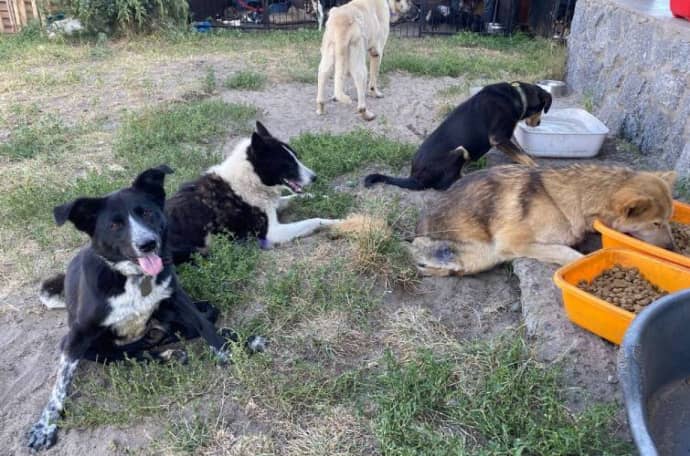 The porch of the House of Special Tails shelter.
The porch of the House of Special Tails shelter.
All photos: Ukrainska Pravda. Zhyttia
Guests are greeted by a dozen dogs on the doorstep of the "House of Special Tails": Khlibchyk [Bread] who has brain damage, Chernysh who was rescued from Kherson, Yizhak [Hedgehog] who is blind in one eye, Zhuzha who has a limp and Bahira who was hit by a car, and playful Lapusik without a back left paw... Animals with disabilities manage to do everything by themselves in the yard.
The guests are watched over by healthy or cured dogs in cages under the fence along the perimeter of the porch. "We keep the healthy animals in enclosures because, according to dogs' instinct, the strongest survive, and they can squeeze the sick. We only let them out under supervision," explains Nastia.
Of all the dogs outside, at first glance, Laima the Alabai (a Central Asian shepherd dog breed), which is one of the largest here, seems to be the most alarming. However, any anxiety disappears when you see the dog's mutilated body.
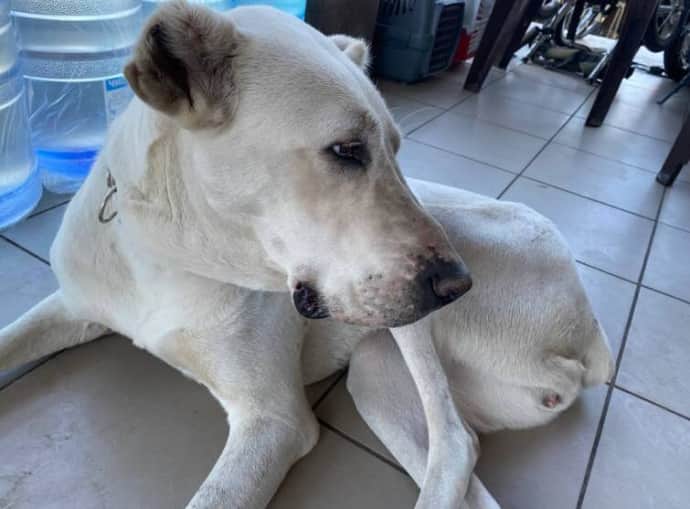 Laima the dog. The military in Bakhmut found this dog, when he was living in a closed kennel
Laima the dog. The military in Bakhmut found this dog, when he was living in a closed kennel
Laima is eighteen months old. He was accidentally discovered by the military in the yard of a bombed-out house in Bakhmut.
The owners probably left the city and left the dog in a closed enclosure without food or water, says the volunteer. It is not known for sure how long the dog lived in the cage. When he was found, he barely moved his head and weighed about 20 kg.
Due to the unfavourable conditions, the muscles of the dog's hind legs became atrophied. "The cage was about two metres high. The muscles of the hind legs have atrophied forever; only surgery will help.
He cannot walk or run normally, and despite his height, he is still not gaining enough weight," says the animal volunteer. Nastia says that, fortunately, she rarely meets animals with such an experience. Almost every month, the military brings new pets to the girl.
"I thought that the limit would be 50 dogs, but now there are about 150. We turn people away if they apply, for example, from non-frontline areas. Also, I do not deal with puppies," the girl explains.
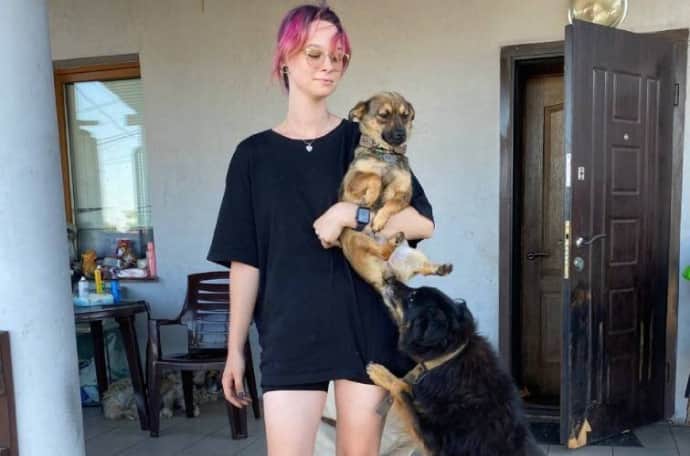 Anastasiia Tykha with her dogs, whom she calls children.
Anastasiia Tykha with her dogs, whom she calls children.
She holds a dog called Khlibchyk in her arms, but Yizhak also really wants to be there
About 50 cats live in the House of Special Tails; some of them are injured. Nastia says that she started taking care of healthy animals in the summer of last year and cats with disabilities since the winter. The girl admits that despite the treatment and help she provides, she doesn't like cats in the same way she likes dogs.
"For me, they are all the same. I have not noticed in cats any kind of attachment to their owners or empathy in their eyes, which, for example, dogs have. The person who feeds me has changed, so they think "oh well" - they are all like that," the girl says.
The hardest part for cats is getting used to a new territory - they need more time for this compared to dogs, adds Nastia.
Finished four years of university and took academic leave of absence
 Lloyd the dog from the city of Chasiv Yar, Donetsk Oblast. The dog was hit by a car, after which he could barely move his hind legs, and his weight dropped to 11 kg. After the operation, the dog began to crawl, and now he feels much better
Lloyd the dog from the city of Chasiv Yar, Donetsk Oblast. The dog was hit by a car, after which he could barely move his hind legs, and his weight dropped to 11 kg. After the operation, the dog began to crawl, and now he feels much better
Nastia is from Kyiv, but when her parents decided to start a kennel for purebred Bullmastiff dogs when she was a child, the family moved to Kyiv Oblast.
In her teenage years, the girl met her future husband Artur, with whom she moved to live in Irpin. "I fell in love with Irpin because it is a city of dogs. It seems that a dog lives in every apartment, every house," the volunteer admits.
Nastia says she has liked to care for and treat animals since childhood, so she did not hesitate to choose veterinary medicine as her future profession. When the full-scale war began, the girl was finishing her fourth year of study. She recalls how the decision to evacuate was made in the first days of March 2022.
The main thing that stopped her, says the girl, was not knowing where to live with all the animals, which numbered about 20: dogs, cats, a chameleon, a turtle, a hamster and a spider. "A volunteer friend found a place for all of us. There was no kitchen or toilet, but there was a bath for the dogs.
At first, everything suited us. Then, when people started sharing my photos on social media, we were offered accommodation by Ukrainians who had been living in Italy for a long time. They had a gorgeous house," the girl shares her memories.
After a month and a half of travelling, after Kyiv Oblast was liberated, the shelter volunteer returned home to Irpin with her family.
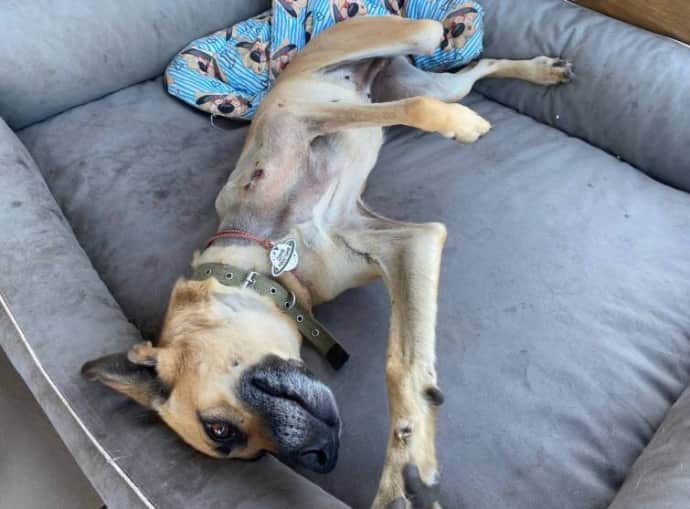 Lapusik the dog from Donetsk Oblast. The dog was brought to the shelter without a hind leg or tail
Lapusik the dog from Donetsk Oblast. The dog was brought to the shelter without a hind leg or tail
This year, Nastia is on academic leave. She doesn't have a problem with continuing her strudies, she says, because she wants to do so, however she doesn't have time for everything.
Now, the girl works as an estate agent. She was introduced to this field by her husband, who does this work remotely abroad. "Thanks to my work, I have a position - my husband and I run the shelter, and in terms of treating animals, I may occasionally ask people to help cover the bills.
Somehow, people helped us cover the costs for treatment of 300,000 hryvnias [approx. US£8,122]," the girl says and adds that people who care also often bring food, carriers, beds, nappies, etc.
Broken skull, knocked-out teeth, torn-off tail
Nastia explains her desire to take care of injured animals by the fact that there are not many shelters for animals with disabilities. In addition, the girl calls herself empathetic and inquisitive.
"They are like special children, each with their own character and history. I feel happy when I realise we rescued these little miracles, despite the fact they had little chance of life," the volunteer explains while petting a dog nicknamed Yizhak. The dog is one of her favourites; his full name is Yezhyslav.
The black yard dog is blind in one eye and only has two teeth. The dog is 16 years old.
 Nastia's favourite dog is Yizhak. The girl said they gave the dog this nickname because of its porous hair
Nastia's favourite dog is Yizhak. The girl said they gave the dog this nickname because of its porous hair
"He got into a car accident twice.
And talking about his teeth, I think they were knocked out by a kick as his jaw was broken. He is very nasty, sometimes he attacks dogs, bites, and does not obey. No one at the shelter likes him, but he is my special dog.
The older and sicker the animal is, the more you want to surround it with great care," Nastia says. Animals ageing from one month to 19 years old live in the shelter. And Nastia says dealing with young creatures with emotional trauma is most challenging.
A one-year-old dog can develop childhood traumas or triggers so it can be afraid of people or only women or men, specific sounds or things. "There was a dog that was hit against a tree and after that it was afraid of trees. We had a dog that was afraid of mops and hid every time it saw one.
It was difficult to look after a dog that was bitten by a shepherd dog in childhood, and after that, it hated them. And, by the way, there are shepherd dogs in the shelter," the volunteer says. In such cases, Nastia gets rid of the triggers, and, thanks to her work with a dog trainer, the animals gradually change their attitude toward those things and get used to them.
In addition, there are animals with physical injuries. A dog, nicknamed Boss, came to the shelter without two front paws. The girl says they were chopped off, with one near the knee and the other near the wrist.
Only two people can be near this dog. An open kennel was created for the dog, and now this is a place it rarely leaves. There is a dog named Samantha from Mykolaiv in the shelter, who is not socialised.
The dog lived in a shelter in Kharkiv for a long time and she moved to Kyiv Oblast after February 2022. Samantha was disabled and in recent years the dog has been living with this disability. "She gave birth to puppies, which people decided to kill by kicking them.
The mother tried to protect her children, but the dog injured its spine, and her hind legs were paralysed. She hates people and is afraid when they come near her," Nastia says.
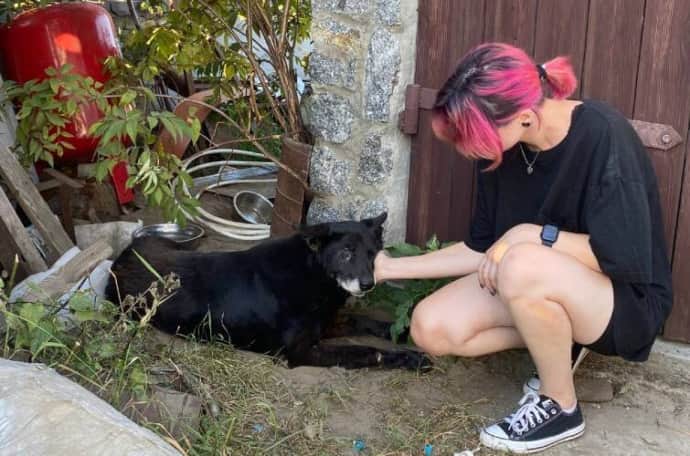 Did [Grandpa] the dog lives behind the cellar, located at the shelter
Did [Grandpa] the dog lives behind the cellar, located at the shelter
The "savage" dog in the shelter is called Did [Grandfather], and it always keeps itself apart from the others.. "People beat him on the head either with a bat or a hammer.
His skull was broken, his teeth were knocked out, and his tail was torn off," the girl says.
Purebred animals are more likely to face cruelty
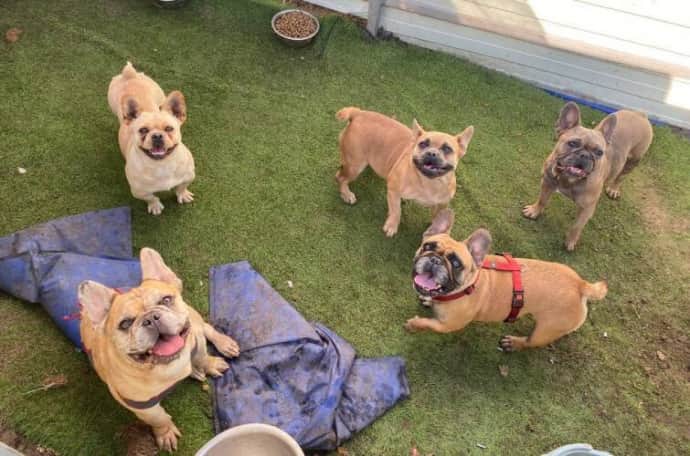 French bulldogs and dachshund crossbreeds rescued from puppy farms
French bulldogs and dachshund crossbreeds rescued from puppy farms
There are 90 dogs in the shelter, including 20 purebreds. In particular, Alabais, Kangal shepherd dogs, German Shepherds, Boxers, French Bulldogs, Pomeranians, and Yorkshire Terriers. "Often they come to us from illegal puppy farms, where animals that are blood relatives are mated, and so their children are born weaker due to the resulting blood mix.
Plus, they are living in inappropriate conditions," Nastia says. Thus, several French bulldogs, a Pomeranian Spitz, and a four-year-old bulldog with paralysed hind legs ended up in the shelter. It took only one month of living in the shelter for the dog to adapt and find a comfortable, cool place near the food bowl.
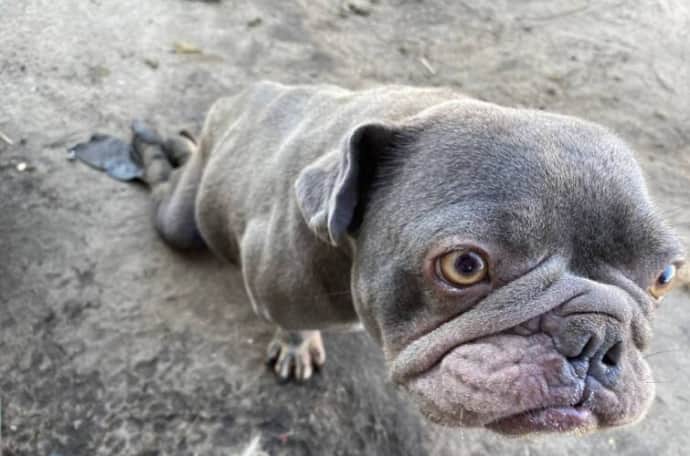 Injured French bulldog.
Injured French bulldog.
The dog does not have
a unique nickname, everyone in the shelter simply calls her Bulldog"The dog had a multiple pregnancy, her spine sagged under the weight of the foetuses and pinched her spinal cord, which paralysed her hind legs. The humans [owners - ed.] did not ask for help and decided to wait until the puppies were born. They took the offspring away for sale, and the dog is now with us," the girl says.
There is no chance of making her paws function again, so a wheelchair was created for the bulldog. Nastia said people treat purebred animals with cruelty more often, particularly because they require more precious care.
Sometimes a dog does not want to be treated
When new animals arrive at the shelter, they first undergo a physical examination, including a blood test, an ultrasound of the abdominal cavity organs and heart, and an MRI if needed. After that, the animals are neutered and vaccinated.
"Examination and diagnosis of each animal cost 2,000-3,000 hryvnias [£54-81 - ed.]. If the animal has a disability, examining it costs about 5,000 hryvnias [£135 - ed.]. If it needs an operation, the sums get larger.
One dog even had bullets in its spine. It took 38,000 hryvnias [£1,028 - ed.] to remove the bullet and clean the injury," Nastia says.
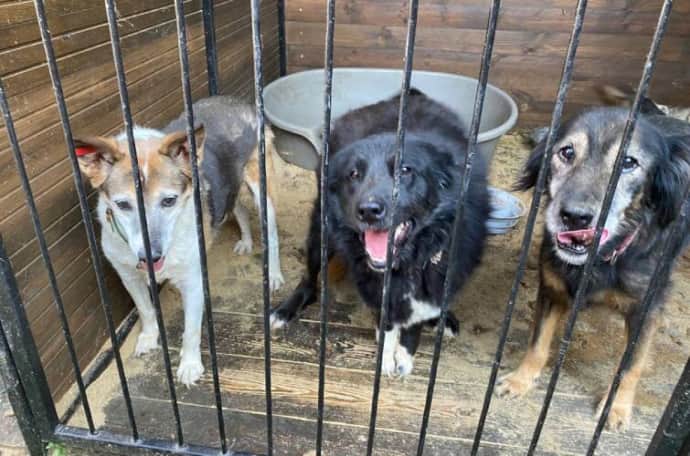 Healthy or cured animals live separately in the kennel. Nastia says that she is afraid to put her hand into some cages to pet an animal, for example
Healthy or cured animals live separately in the kennel. Nastia says that she is afraid to put her hand into some cages to pet an animal, for example
Adaptation to a new place and rehabilitation is different for all animals.
The girl added that age and past experience affect this process. "During my five years of working with animals, there have been two cases when a dog did not want to be treated, or to live. This was due to the attachment the dog had to the people from whom it was separated and because of an injury or illness.
In such a state, the dog stops eating and its gaze changes. It doesn't watch you or raise its head, it isn't interested, and stops sniffing anything," the volunteer says. If this happens, volunteers forcibly feed the animal until its appetite reappears.
"The shelter has a Cane Corso [large mastiff type] dog whose owner was killed in the war. The dog lived with his wife for a while, but they brought it to us in the end. You can hear the sadness in his bark, and it seems the dog is constantly looking for someone, probably his owner," Nastia adds.
Can people adopt an animal from the shelter?
Every animal that lives in the shelter is looking for a family.
However, anyone wanting to adopt an animal first must prove their willingness. "If you are ready for the specifics of the animal, its illness and condition, and are intending to adopt a specific animal, you fill out a questionnaire about yourself, we communicate with you, and then you can adopt the animal for a trial week. If everything goes well after this trial, congratulations, you have a pet.
I will be your personal animal consultant 24/7," Nastia says.
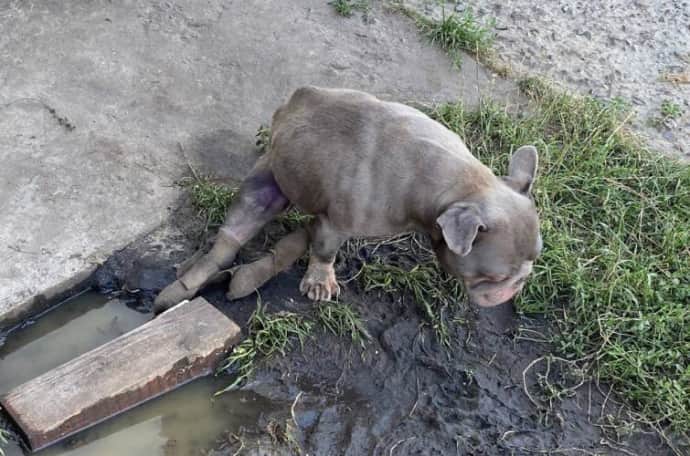 Bulldog who likes to spend time in the shade on the cool grass
Bulldog who likes to spend time in the shade on the cool grass
If the dog is purebred, the volunteer asks for payment by cheque for its treatment. The funds will be allocated to the shelter's development. Nastia says they have managed to find families for one or two dogs with disabilities during the past years.
Animals are often sent abroad, particularly to Ukrainian refugees. Nastia said potential animal owners often have to be turned down. "For example, one family told me that their animals cannot be vaccinated," Nastia says.
Sometimes, new owners return the animals. The girl says a Pomeranian has been returned to the shelter four times. After a few weeks in a new family, this dog allegedly shows its natural character.
"Now we are reorganising the shelter a little so that people can come to us, walk the dogs and help care for the animals. We want to separate those who have been socialised from those who are still savage," the volunteer says. It takes 25 kg of food to feed the animals for one day.
House of Special Tails needs help, and you can do this by following this link. Anastasiia Poia for Ukrainska Pravda. Zhyttia
Translation: Yelyzaveta Khodatska, Tetiana Buchkovska
Editing: Susan McDonald